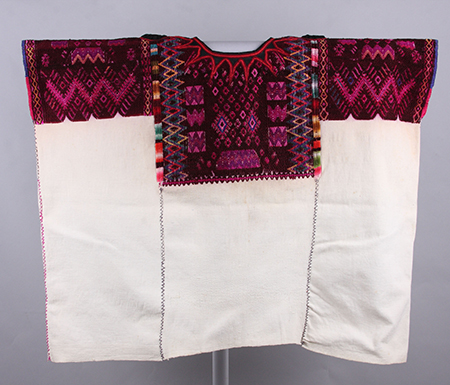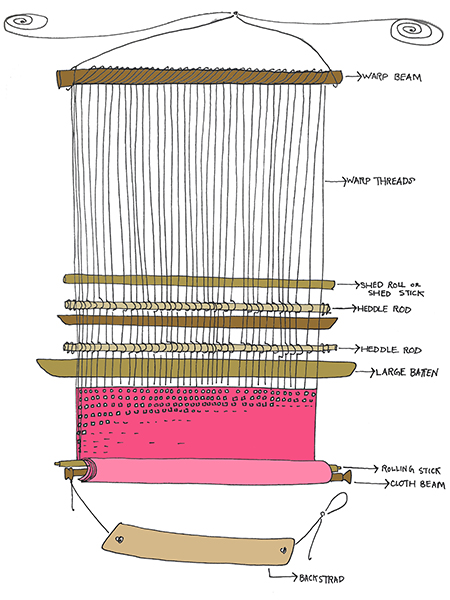

Detail. Handwoven Quiché Cotton Huipil, San Tomas Chichicastenango, Guatemala. Holzapfel Collection MMA 2007.74.1
UNM Museum Studies Master’s student Petra Brown has been conducting research on Central American Mayan textiles and textile tools in the Holzapfel Collection of the Maxwell Museum’s ethnology division. Here is her report:
-------------------------------
In Maya cosmology, the Moon goddess Ix Chel guards the gifts of weaving, childbirth, and medicine. Ix Chel bestowed the knowledge of weaving to the Maya more than 3,500 years ago (Rosenbaum 2015: xxi). The Moon Goddess grants the power of birth, life, creativity, and the arts to Maya women who, in turn, embody these skills. Thus, to the Maya, textiles are not woven but are born (Prechtel and Carlsen 1988: 123), as every aspect of the weaving process—each tool, design, and weaver—is part of the sacred birthing process. By placing a huipil (traditional woven female blouse) over the head, the wearer is symbolically and literally placed in the center of the universe, as the brocaded designs around the neck often symbolize the cosmos. Through this act, women accept the cultural responsibilities associated with its wear: to provide and sustain life and to be a beacon for the continuity of cultural traditions (Nash 2015: 24).

This is an example of a Quiché huipil, made of three panels with sleeves and a rounded neck. The brocaded diamonds and zigzags demonstrate a Maya’s relationship with the natural and spiritual worlds. The sunbeam design around the neck illustrates the wearer radiating rays from the sun, as she is at the center of the universe within the garment.
The backstrap loom has been used by the Maya for at least 2,000 years (Prechtel and Carlsen 1988: 124). The loom is inexpensive to assemble and designed to be portable. The warp (vertical yarn) is set on the loom and remains stationary, holding the loom and the textile's structure in place. The various tools used to form textiles are usually gathered locally, carved, and placed along the warp to create tension, hold the warp in place, and enable the creation of designs. These tools include the warp beams, heddles, shuttles, battens, and rolling sticks.

Tension is also controlled by the backstrap attached to the bottom beam of the loom and wound around the weaver's waist. The top beam is then attached to the R'tie Ghie, or Mother Tree, by rope or yarn. The Mother Tree anchors both the backstrap loom and the weaver. As the weaver leans backward and forward, tension changes. She alters her position to achieve various outcomes (Odland 2006: 16).
The backstrap loom holds great cosmological meaning, while the loom and tools personify the human body. Just as the navel is the source of new human life, the Mother Tree is the source of a huipil’s life. Without either the navel or the Mother Tree, a new creation could not come into existence. Humans and weavings are both born from women. The Mother Tree and navel are sources of life, and each tool simultaneously supports birth and symbolizes the body. For example, in the Maya Tzutujil language, the back loom beam, or rwa kiem, means "the weaving's head." The front loom beam is r'chaq kiem, or the "bottom/butt," the lease stick is tkr, "ribs," and the r'way kiem, or shuttle, translates as "sustenance" (Prechtel and Carlsen 1988: 125-126).
Shuttles (see illustrations below) are tools used to transport horizontally added yarn (weft) left to right and right to left through separated warp yarns. The elongated shape of the shuttle makes it easier for the weaver to fit the material through the warp while keeping the yarn from tangling. The shuttle and the yarn it carries quite literally add sustenance to the textile’s body. The shuttle travels through the mouth of the weaving, also known as the shed or r'kux. The shed is the space the shuttle moves through in between separated warp yarns. The continuous opening and closing of the shed through the alternating warps are analogous to the beating heart (Prechtel and Carlsen 1988: 126). The heart sustains us and makes human bodies grow, develop, and function. As weft builds, the fabric grows and develops as a complex woven body.
Today when Maya women weave, they not only connect with their long line of weaving ancestors but also with the deities who taught their ancient family the power of weaving, bringing life into the world as both mothers and artists. Huipils are a sign of belonging among Maya who identify as females. As women weave, they are participating in ancient sacred practices while maintaining cultural continuity (Rosenbaum 2015: xii).
References:
Carlsen, Robert S. and Prechtel, Martin. “Weaving and Cosmos Amongst the Tzutujil Maya of Guatemala.” RES: Anthropology and Aesthetics, The University of Chicago Press on behalf of the Peabody Museum of Archaeology and Ethnology, Spring, 1988, No. 15 (Spring, 1988), pp. 122- 132.
Nash, June. "Mayan Artisan Production: Creation of the World and Recreation of Another World." In, Artisans and Advocacy in the Global Market: Walking the Heart Path, ed. by J. Simonelli, K. O'Donnel, and J. Nash, pp. 19-37. Santa Fe: School for Advanced Research Press, 2015.
Odland, J. Claire. “Fashioning Tradition: Maya Huipils in the Field Museum Collections.” Fielding Anthropology, April 17, 2006, New Series, No. 38, (April 17, 2006), pp. i-67 https://www.jstor.org/stable/4176199.
Rosenbaum, Brenda. "Foreward," In, Artisans and Advocacy in the Global Market: Walking the Heart Path, ed. by J. Simonelli, K. O'Donnel, and J. Nash, pp. xi-xviii. Santa Fe: School for Advanced Research Press, 2015..
Tedlock, Barbara and Tedlock, Dennis. “Text and Textile: Language and Technology in the Arts of the Quiché Maya.” Journal of Anthropological Research, Summer, 1985, Vol. 41, No. 2, (Summer, 1985), pp. 121-146 https://www.jstor.org/stable/3630412 .
Loom drawings, figure captions:
Backstrap loom diagram with labeled parts and tools. (Adapted from Pedro Mesa M.Luchetik: El Lenguaje Textil de Los Altos De Chiapas, by Petra Brown and Lauren Fuka).
Backstrap loom attached to a Mother Tree (Adapted from Pedro Mesa M.Luchetik: El Lenguaje Textil de Los Altos De Chiapas, by Petra Brown and Lauren Fuka).